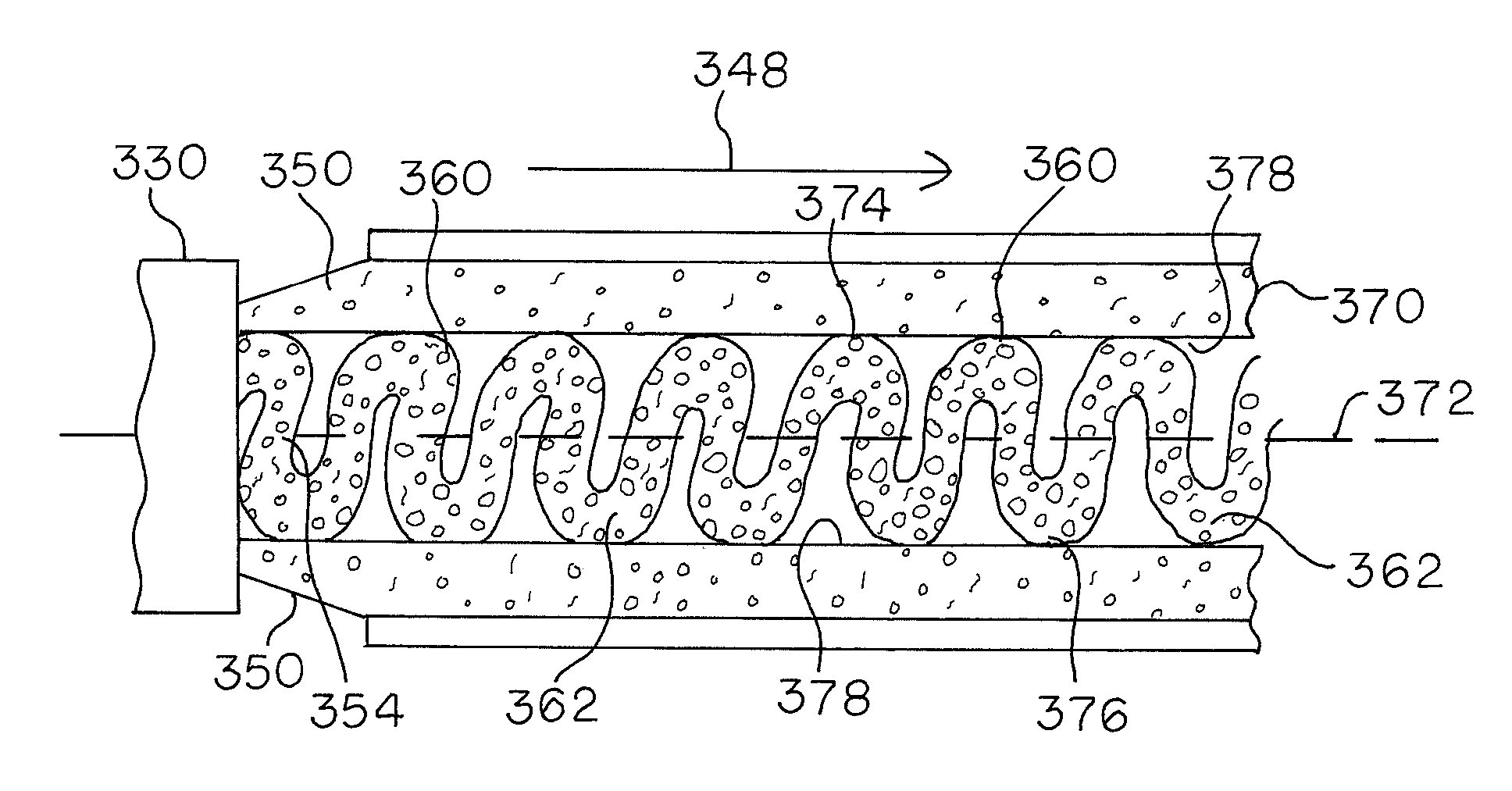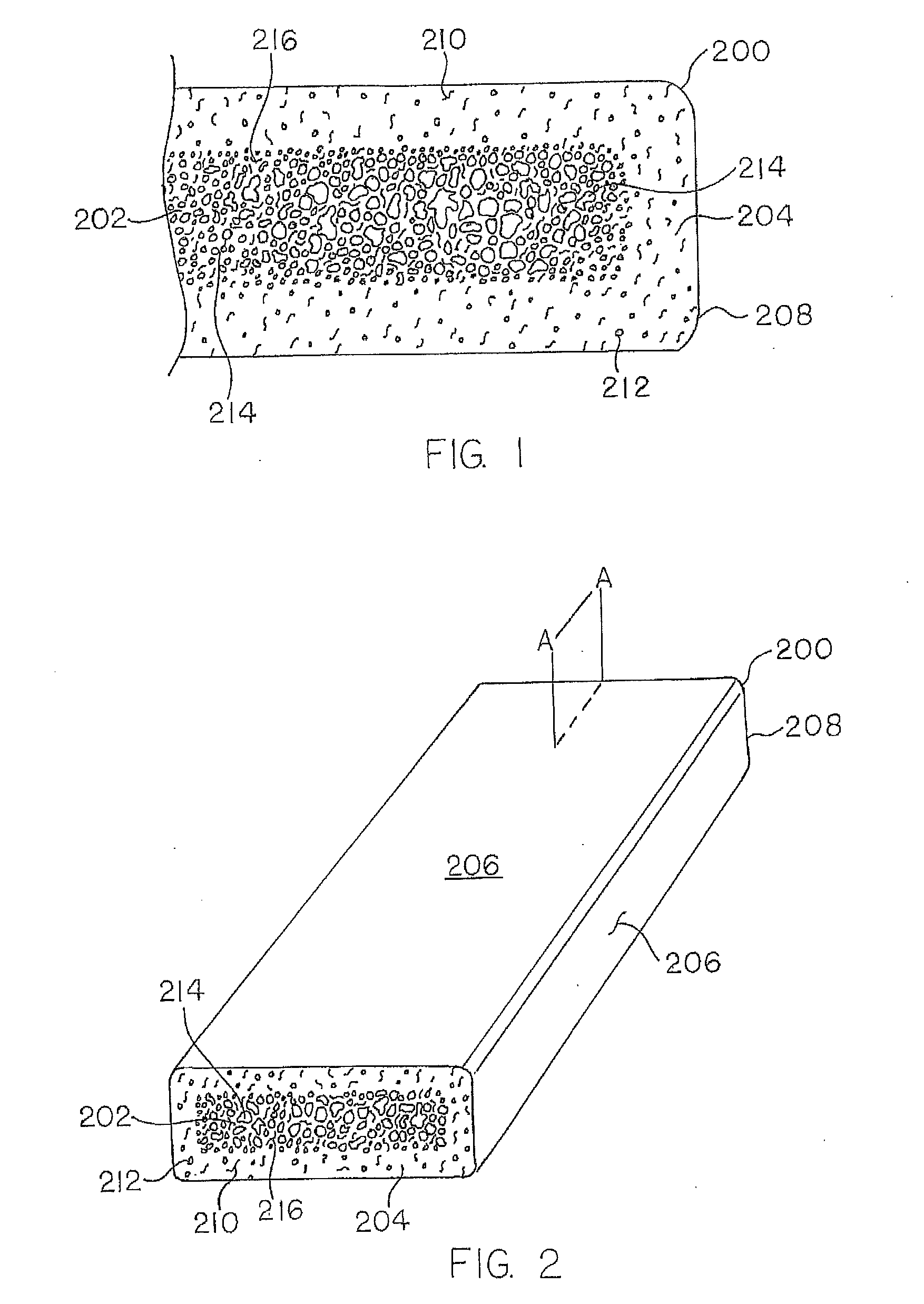Method of making cellulosic filled thermoplastic composites of an anhydride containing copolymer
a polymer and thermoplastic composite technology, applied in the field of making a thermoplastic composite material, can solve the problems of high labor intensity of wood fences or wood decks, high maintenance costs of wood fences or decks, and heavy and cumbersome solid wood components
- Summary
- Abstract
- Description
- Claims
- Application Information
AI Technical Summary
Problems solved by technology
Method used
Image
Examples
examples
[0201]The following equipment was used in processing the examples described below.[0202]Extrusion processing was carried out using a WT-94 WOODTRUDER® extruder using a 94 mm counter-rotating parallel twin-screw extruder (T94, 28:1 L / D) with a coupled Mark V® 75 mm single-screw extruder (T75) available from Davis-Standard Corporation, Pawcatuck, Conn.[0203]Gravimetric feeders (Colortronic North America, Inc., Flint, Mich.) were used to supply the extruders.[0204]Styrene-Maleic Anhydride (SMA) resins used were DYLARK® 238, resin, DYLARK® 332 resin and DYLARK® 378 resin available from NOVA Chemicals Inc., Pittsburgh, Pa.[0205]Cellulosic fiber used was 40 mesh pine sawdust available from American Wood Fibers, Inc., Schofield, Wis.
[0206]Lubricant was EPOLENE® wax (EW) available from Eastman Chemical Company, Kingsport, Tenn. or STRUKTOL® fatty acid ester (FA) available from Schill & Seilacher GmbH, Hamburg, Germany.
examples 1-5
[0207]Wood filled SMA samples were prepared using a free foaming die and the combinations of ingredients in the following table. All values are weight percentages.
ExampleSMA ResinCellulosicLubricantNo.typeSMAfiber(EW)133270255233269256337878184437870255537864306
[0208]The following extrusion parameters were used to prepare each of Examples 1-5.
WOODTRUDER ®Mark V ®ExtruderParameterextruder(T94)Barrel Zone 1 (° C.)250 30Barrel Zone 2 (° C.)240230Barrel Zone 3 (° C.)220225Barrel Zone 4 (° C.)210220Barrel Zone 5 (° C.)205210Barrel Zone 6 (° C.)—205Barrel Zone 7 (° C.)—205Barrel Zone 8 (° C.)—200Melt (° C.)205—Adapter (° C.)220220Clamp (° C.)220220Pressure (psi)1600-170025-100Load (%) 46 19Screw Speed (rpm) 37 24
[0209]During the extrusion process, a blowing agent was generated, believed to be either water, carbon dioxide, or a combination thereof, resulting from reaction of the anhydride groups of the SMA and the hydroxyl groups of the cellulosic fiber. The blowing agent caused a foam str...
examples 6-8
[0221]Wood filled SMA samples were prepared using a Celuka-type foaming die available from Futuresoft Technologies Inc., Manalapan, N.J. and the combinations of ingredients in the following table. All values are weight percentages.
ExampleSMA ResinCellulosicLubricantNo.typeSMAfiber(FA)623860355723850455833250455
[0222]The following extrusion parameters were used to prepare each of Examples 6-8 at an output rate of 152.5 pounds per hour and extrusion rate or line speed of 12 inches per a minute through the Celuka type foaming die.
ParameterT75T94DieZone 1 (° C.)250 30190Zone 2 (° C.)240165190Zone 3 (° C.)220175190Zone 4 (° C.)210210—Zone 5 (° C.)205205—Zone 6 (° C.)—200—Zone 7 (° C.)—195—Zone 8 (° C.)—195—CD (° C.)——150Melt (° C.)202186—Adapter (° C.)220—200Clamp (° C.)220——Pressure (psi)1104-1170550-620—Load (%) 30 21—Screw Speed 20 19—(rpm)
[0223]Vacuum venting was applied to control the degree of foaming. At high vacuum, around 30 mm Hg, the foaming tendency was decreased. Improved fo...
PUM
| Property | Measurement | Unit |
|---|---|---|
| density | aaaaa | aaaaa |
| diameter | aaaaa | aaaaa |
| density | aaaaa | aaaaa |
Abstract
Description
Claims
Application Information
 Login to view more
Login to view more - R&D Engineer
- R&D Manager
- IP Professional
- Industry Leading Data Capabilities
- Powerful AI technology
- Patent DNA Extraction
Browse by: Latest US Patents, China's latest patents, Technical Efficacy Thesaurus, Application Domain, Technology Topic.
© 2024 PatSnap. All rights reserved.Legal|Privacy policy|Modern Slavery Act Transparency Statement|Sitemap



